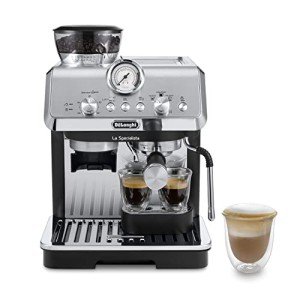Heat Exchange Espresso Machines: A Comprehensive Guide
Espresso machines have evolved considerably for many years, catering to the requirements of home baristas and coffee professionals alike. Amongst these machines, heat exchange espresso machines have actually gotten popularity due to their capability to provide consistent performance and extraordinary brew quality. In this short article, we will check out the functions, benefits, and essential functions of heat exchange espresso machines, supplying a thorough understanding for both prospective purchasers and coffee lovers.
Comprehending Heat Exchange Technology
Heat exchange espresso machines operate on an unique concept that allows synchronised water heating for developing and steaming. Dual Boiler Espresso Machines are equipped with a single boiler that uses a heat exchanger system. This feature is significant as it allows users to brew espresso while steaming milk concurrently, promoting effectiveness in the coffee-making procedure.
How Does a Heat Exchange Espresso Machine Work?
The process starts with the machine's water inlet filling the boiler. As the water heats up, it turns to steam. The ingenious heat exchanger uses hot steam to heat additional water in a different passage developed specifically for the brew group. This suggests that water can reach the perfect brewing temperature without awaiting the boiler to adjust. The key actions include:
- Water Fill: Water is drawn into the boiler.
- Heating Process: The boiler heats up as water is converted into steam.
- Heat Exchange: Steam heats up water in the heat exchanger tube.
- Brewing: Water from the heat exchanger is pushed through coffee premises, drawing out the tastes required for an abundant espresso.
This process permits fast temperature modifications and enhanced coffee extraction.
Advantages of Heat Exchange Espresso Machines
Heat exchange espresso machines offer several advantages, especially for those looking to maximize their coffee experience. Here are some key benefits:
- Simultaneous Brewing and Steaming: Users can brew espresso while steaming milk, making it perfect for busy coffee shops and home baristas who value performance.
- Temperature level Stability: The boiler's steam pressure assists keep a stable temperature level, which is critical for consistent espresso extraction.
- Versatility: The design permits quick switching in between brewing and steaming, making it easier to develop numerous coffee drinks, from lattes to cappuccinos.
- Easy to use: Models typically come with accessible controls, making it possible for both newbies and experienced baristas to produce quality beverages.
- Professional Quality: Heat exchange machines are frequently utilized in commercial settings, supplying users with high-quality brewing efficiency in the house.
Key Features to Look for in Heat Exchange Espresso Machines
When thinking about the purchase of a heat exchange espresso machine, there are a number of functions that one should take into consideration:
- Build Quality: Look for machines made of durable products, such as stainless-steel or brass, guaranteeing durability.
- Boiler Size: A bigger boiler will hold more water and sustain higher output over time.
- PID Temperature Control: This function assists keep constant brew temperatures, which can enhance the coffee-making procedure.
- Group Head Design: Machines with a saturated or semi-saturated group head provide much better temperature level stability.
- Reduce of Use: User-friendly interfaces and intuitive controls improve the overall experience for baristas at all ability levels.
- Steam Wand Quality: A good steam wand with correct insulation and versatility enables for better texturing of milk.
- Water Reservoir Size: Depending on your requirements, consider how typically you wish to fill up the water tank.
Contrast of Popular Heat Exchange Espresso Machines
To much better understand the choices readily available in the market, listed below is a comparison table of some popular heat exchange espresso machines:
| Machine Model | Boiler Size | PID Control | Cost Range | User Ratings |
|---|---|---|---|---|
| Profitec Pro 700 | 2.0 L | Yes | ₤ 2,000-₤ 2,500 | 9.5/ 10 |
| Rocket Espresso R58 | 1.8 L | Yes | ₤ 2,400-₤ 2,800 | 9.4/ 10 |
| Elekta Bianca | 1.8 L | Yes | ₤ 2,500-₤ 3,000 | 9.6/ 10 |
| La Spaziale S1 Vivaldi II | 1.5 L | Yes | ₤ 1,800-₤ 2,200 | 9.2/ 10 |
| Bezzera Magica | 1.2 L | No | ₤ 1,600-₤ 1,800 | 9.0/ 10 |
Frequently Asked Questions About Heat Exchange Espresso Machines
What is the main difference between a heat exchange and a dual boiler espresso machine?
While both types can brew espresso and steam milk at the very same time, dual boiler machines have separate boilers for brewing and steaming. In contrast, heat exchange machines use a single boiler and a heat exchanger to achieve the same function.
Are heat exchange machines appropriate for novices?
Yes! Lots of heat exchange machines are designed with user-friendly features, making them available for novices. With proper assistance and practice, users can quickly produce quality espresso.
What type of maintenance do heat exchange espresso machines require?
Regular maintenance includes descaling, cleaning the boiler, checking seals and gaskets, and keeping the group head tidy. Routine maintenance guarantees longevity and consistent efficiency.
Can I use a heat exchange machine for different kinds of coffee drinks?
Definitely! Heat exchange machines allow users to develop a range of coffee beverages, including espresso, lattes, cappuccinos, and more.
Heat exchange espresso machines represent a blend of innovation and tradition, offering coffee enthusiasts with the tools needed for crafting the best cup. Their capability to all at once brew and steam, integrated with precise temperature level control, makes them an engaging choice for both home baristas and experts. With the best understanding on features and maintenance, users can unlock a world of elegant coffee experiences, ensuring that each sip is as delightful as the last.

